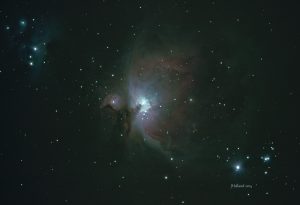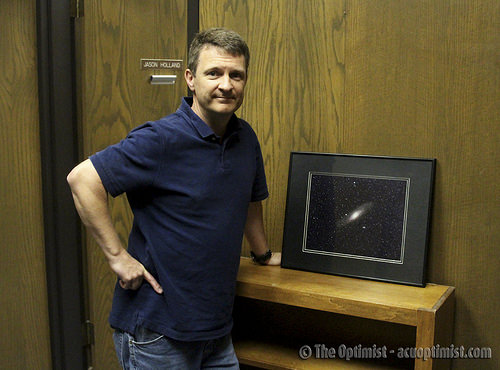Dr. Jason Holland, professor of mathematics, teaches students about discreet algebra and math theory. But hanging on the walls of his office in Foster Science Building are photographs of nebulae, galaxies and star clusters – and they’re all taken by Holland himself.
Holland discovered his love for astrophotography in 2012 after he got his first high-quality telescope.

Waxing moon. (courtesy of Jason Holland)
“I took an iPhone photo of the moon, holding the iPhone over the eyepiece,” he said. “That turned out pretty well, and I thought, ‘Wow. How can I do this better?'”
Three years later, Holland has moved beyond taking pictures on his phone to acquiring the equipment and knowledge necessary to photograph moving objects that are millions of light-years away.
Holland said, as a math guy, he enjoys all the variables that have to be exactly right to capture a good photo of an object in the sky.
“One of things I like about astrophotography is there are so many things that can go wrong,” he said. “You have to really control all the elements in order to get a good photo.”
First, there’s the fact that objects being shot are moving. Because of the earth’s rotation, the stars rotate through the sky. Astrophotographers use an equatorial mount, a motorized device attached to the camera, allowing it to follow the objects while capturing images.
Holland describes the tedious task of setting the camera to be precisely “polar-aligned.”
“We live at 34 degrees north,” he said. “So I turn it to 34 degrees north, and I make sure I look through this hole and make sure I can see the North Star, and then some other fine-tuned technical adjustments.”
Then there’s the lighting. Because stars after often so faint to the human eye, the camera has to have the perfect amount of exposure in order to gather enough light data to hits the camera’s sensor.
Holland points to a photo he took last year.
“This picture is a total of 1.5 hours of exposure. Thirty seconds of each exposure was the most I could get before the stars started trailing, and I took 180 of those.”
Holland then used Photoshop to layer all 180 photos into one crisp, bright image.
“When you stack a whole bunch of them, the picture really comes together,” he said.

Orion’s Nebula (courtesy of Jason Holland)
Everything Holland has learned about astrophotography, from the technical skills to the software, has been self-taught. He is also part of an online community of astrophotographers called Astrobin, a website that hosts images and allows astrophotographers from all over the world to upload and share photos they’ve taken.
“It’s a worldwide community, and it’s very diverse,” Holland said. “I follow people from South America, Europe, Australia – we share tips.”
Holland has also found that the best photos are taken against an inky black sky.
“Dark sky rules out having to deal with light pollution,” he said. “I go out to Fort Griffin near Albany and it’s really dark there.”
Although he is a math professor, Holland was first interested by the astronomy side of the hobby. “Visual astronomy” is the term used to describe the hobby of observing the solar system with or without a telescope.
“I love the visual side,” Holland said.
His experience with the observation side of the hobby is helpful when it comes to looking for something to photograph.
“I love to go out with my camera and just be a part of the universe and look at things, but then I really like trying to make everything come together for a good photo.”

